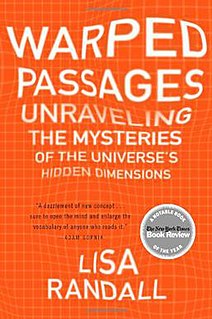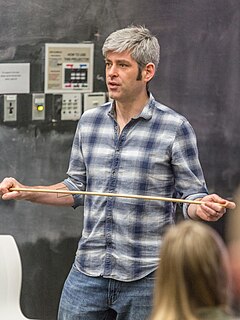Related Research Articles

Physical cosmology is a branch of cosmology concerned with the study of cosmological models. A cosmological model, or simply cosmology, provides a description of the largest-scale structures and dynamics of the universe and allows study of fundamental questions about its origin, structure, evolution, and ultimate fate. Cosmology as a science originated with the Copernican principle, which implies that celestial bodies obey identical physical laws to those on Earth, and Newtonian mechanics, which first allowed those physical laws to be understood.

Brian Randolph Greene is an American theoretical physicist, mathematician, and string theorist. Greene was a physics professor at Cornell University from 1990–1995, and has been a professor at Columbia University since 1996 and chairman of the World Science Festival since co-founding it in 2008. Greene has worked on mirror symmetry, relating two different Calabi–Yau manifolds. He also described the flop transition, a mild form of topology change, showing that topology in string theory can change at the conifold point.
Frank Jennings Tipler is an American mathematical physicist and cosmologist, holding a joint appointment in the Departments of Mathematics and Physics at Tulane University. Tipler has written books and papers on the Omega Point based on Pierre Teilhard de Chardin's religious ideas, which he claims is a mechanism for the resurrection of the dead. He is also known for his theories on the Tipler cylinder time machine. His work has attracted criticism, most notably from George Ellis who has argued that his theories are largely pseudoscience.

Cumrun Vafa is an Iranian-American theoretical physicist and the Hollis Professor of Mathematics and Natural Philosophy at Harvard University.

John David Barrow was an English cosmologist, theoretical physicist, and mathematician. He served as Gresham Professor of Geometry at Gresham College from 2008 to 2011. Barrow was also a writer of popular science and an amateur playwright.

Lisa Randall is an American theoretical physicist working in particle physics and cosmology. She is the Frank B. Baird, Jr. Professor of Science on the physics faculty of Harvard University. Her research includes elementary particles, fundamental forces and dimensions of space. She studies the Standard Model, supersymmetry, possible solutions to the hierarchy problem concerning the relative weakness of gravity, cosmology of dimensions, baryogenesis, cosmological inflation, and dark matter. She contributed to the Randall–Sundrum model, first published in 1999 with Raman Sundrum.

Cosmology is a branch of metaphysics dealing with the nature of the universe. The term cosmology was first used in English in 1656 in Thomas Blount's Glossographia, and in 1731 taken up in Latin by German philosopher Christian Wolff, in Cosmologia Generalis. Religious or mythological cosmology is a body of beliefs based on mythological, religious, and esoteric literature and traditions of creation myths and eschatology. In the science of astronomy it is concerned with the study of the chronology of the universe.

Warped Passages: Unraveling the Mysteries of the Universe's Hidden Dimensions is the debut non-fiction book by Lisa Randall, published in 2005, about particle physics in general and additional dimensions of space in particular. The book has made it to top 50 at amazon.com, making it the world's first successful book on theoretical physics by a female author. She herself characterizes the book as being about physics and the multi-dimensional universe. The book describes, at a non-technical level, theoretical models Professor Randall developed with the physicist Raman Sundrum, in which various aspects of particle physics are explained in a higher-dimensional braneworld scenario. These models have since generated thousands of citations.

Sean Michael Carroll is an American theoretical physicist and philosopher who specializes in quantum mechanics, gravity, and cosmology. He is a research professor in the Walter Burke Institute for Theoretical Physics in the California Institute of Technology (Caltech) Department of Physics and an External Professor at the Santa Fe Institute. He is going to be Homewood Professor of Natural Philosophy at Johns Hopkins University in Baltimore from the summer of 2022. He has been a contributor to the physics blog Cosmic Variance, and has published in scientific journals such as Nature as well as other publications, including The New York Times, Sky & Telescope and New Scientist. He is known for atheism, critique of theism and defense of naturalism. He is considered a very prolific public speaker and science populariser. In 2007, Carroll was named NSF Distinguished Lecturer by the National Science Foundation.
Astroparticle physics, also called particle astrophysics, is a branch of particle physics that studies elementary particles of astronomical origin and their relation to astrophysics and cosmology. It is a relatively new field of research emerging at the intersection of particle physics, astronomy, astrophysics, detector physics, relativity, solid state physics, and cosmology. Partly motivated by the discovery of neutrino oscillation, the field has undergone rapid development, both theoretically and experimentally, since the early 2000s.

The Trouble with Physics: The Rise of String Theory, the Fall of a Science, and What Comes Next is a 2006 book by the theoretical physicist Lee Smolin about the problems with string theory. The book strongly criticizes string theory and its prominence in contemporary theoretical physics, on the grounds that string theory has yet to come up with a single prediction that can be verified using any technology that is likely to be feasible within our lifetimes. Smolin also focuses on the difficulties faced by research in quantum gravity, and by current efforts to come up with a theory explaining all four fundamental interactions. The book is broadly concerned with the role of controversy and diversity of approaches in scientific processes and ethics.

The Boltzmann brain thought experiment suggests that it might be more likely for a single brain to spontaneously and briefly form in a void rather than for the entire universe to come about in the manner cosmologists think it actually did.
Andrew E. Lange was an astrophysicist and Goldberger Professor of Physics at the California Institute of Technology in Pasadena, California. Lange came to Caltech in 1993 and was most recently the chair of the Division of Physics, Mathematics and Astronomy. Caltech's president Jean-Lou Chameau called him "a truly great physicist and astronomer who had made seminal discoveries in observational cosmology".
Bruce Winstein was an experimental physicist and cosmologist noted for his early work in elementary particle physics, particularly work toward demonstrating a serious asymmetry between particles and their anti-particles. Later in his career, he worked in experimental cosmology, measuring polarization in the microwave background radiation whose properties date back to the early universe.
Ni Guangjiong is a Chinese physicist and science writer. He began studies in physics about 1950, and became a Doctor of Philosophy in 1955. He married Su Qing, a physics professor, in 1960. He published his first book in 1978. He holds a Chair in Physics at Fudan University, Shanghai. He is the director of Modern Physics Institute and the head of the Division for Theoretical Physics.

A Universe from Nothing: Why There Is Something Rather than Nothing is a non-fiction book by the physicist Lawrence M. Krauss, initially published on January 10, 2012 by Free Press. It discusses modern cosmogony and its implications for the debate about the existence of God. The main theme of the book is how "we have discovered that all signs suggest a universe that could and plausibly did arise from a deeper nothing—involving the absence of space itself and—which may one day return to nothing via processes that may not only be comprehensible but also processes that do not require any external control or direction."
A black hole firewall is a hypothetical phenomenon where an observer falling into a black hole encounters high-energy quanta at the event horizon. The "firewall" phenomenon was proposed in 2012 by physicists Ahmed Almheiri, Donald Marolf, Joseph Polchinski, and James Sully as a possible solution to an apparent inconsistency in black hole complementarity. The proposal is sometimes referred to as the AMPS firewall, an acronym for the names of the authors of the 2012 paper. The potential inconsistency pointed out by AMPS had been pointed out earlier by Samir Mathur who used the argument in favour of the fuzzball proposal. The use of a firewall to resolve this inconsistency remains controversial, with physicists divided as to the solution to the paradox.

The Aspen Center for Physics is a non-profit Center for research in Physics based in Aspen, Colorado, United States. The Center organizes workshops and conferences to facilitate interactions among research physicists.

Chanda Prescod-Weinstein is an American theoretical cosmologist, and is both an assistant professor of physics and astronomy and a core faculty member in women's and gender studies at the University of New Hampshire. From 2016 to 2018, she was the principal investigator on a Foundational Questions Institute (FQXI) grant titled "Epistemological Schemata of Astro | Physics: A Reconstruction of Observers."

Daniel Wayne Hooper is an American cosmologist and particle physicist specializing in the areas of dark matter, cosmic rays, and neutrino astrophysics. He is a Senior Scientist at Fermi National Accelerator Laboratory and an Associate Professor of Astronomy and Astrophysics at the University of Chicago.
References
- ↑ Physics World, February 2007
- ↑ Nature 442, 9 (6 July 2006)
- ↑ "Lisa Randall; On Gravity, Oreos and a Theory of Everything", Dennis Overbye, New York Times, November 1, 2005
- ↑ "At Fermilab, the Race Is on for the ‘God Particle’", Dennis Overbye, New York Times, July 24, 2007
- ↑ "Cupid Takes to the Road, Too", Perry Garfinkel, February 13, 2007
- ↑ Nature 444, 526 (30 November 2006)
- ↑ Polchinski, Joseph (2006-12-07). "All Strung Out?" . Retrieved 2007-07-27.